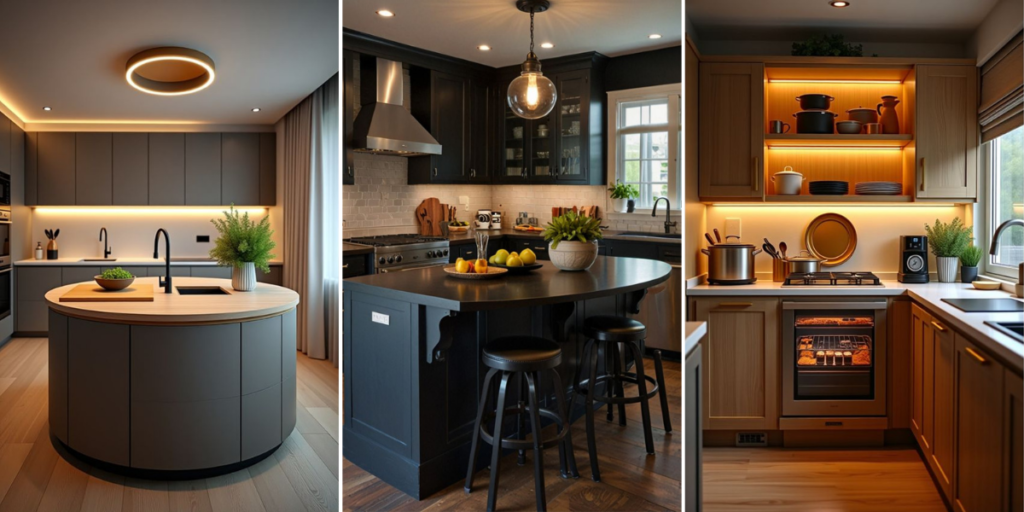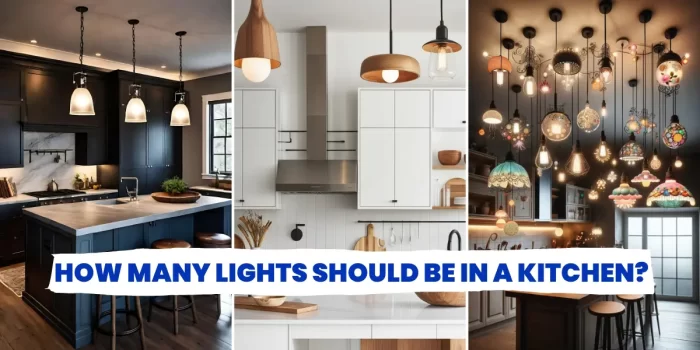Lighting plays a crucial role in making your kitchen both functional and aesthetically pleasing. It impacts everything from cooking to socializing, so choosing the right number and type of kitchen lighting fixtures is essential. But how many lights should be in a kitchen? In this article, we will explore the factors that determine the number of lights, types of kitchen lighting ideas, and pro tips to help you create a well-lit, balanced kitchen space.
Understanding Kitchen Lighting Zones

Before deciding on the number of lights, it’s important to understand the different kitchen lighting layout zones within your kitchen. Each zone serves a specific function and requires different types of lighting:
- Ambient Lighting: This is the general lighting that provides overall illumination for the room. It sets the mood and ensures visibility throughout the kitchen, helping create a bright and inviting space.
- Task Lighting: Focused lighting that helps with tasks such as chopping vegetables, reading recipes, or cooking. Task lighting for kitchens is usually brighter and located over work surfaces like countertops, sinks, and stovetops.
- Accent Lighting: Decorative lighting is used to highlight specific areas like architectural details, artwork, or open shelves. This type of lighting adds depth and character to the space.
- Under-Cabinet Lighting: A popular form of task lighting, under-cabinet kitchen lighting illuminates countertops and eliminates shadows, making food prep easier and safer.
- Pendant Lights: Often used for kitchen islands or dining areas, pendant lights for kitchen islands are both functional and decorative. They can add a stylish touch while providing focused light for tasks like dining or food prep.
Factors That Determine How Many Lights You Need
Several factors come into play when deciding how many lights your kitchen needs:
1. Kitchen Size
The size of your kitchen is the most important factor in determining the number of lights. A small kitchen may need fewer lights, while a larger kitchen will require more kitchen light placement options to ensure even coverage. Kitchens need about 70 to 100 lumens per square foot. Measure your kitchen area and calculate the required lumens to get an estimate.
2. Ceiling Height
The height of your ceiling also affects how much ambient lighting for kitchens is needed. Higher ceilings require more powerful or additional lighting to ensure even coverage. For ceilings above 8 feet, consider using a combination of recessed lights, chandeliers, or pendant lights for kitchen islands to maintain adequate brightness.
3. Work Zones
Think about the areas where you’ll need focused task lighting, such as the countertop, stove, and sink. Task lighting should be placed in these specific work zones to ensure proper visibility for cooking, cleaning, and food preparation.
4. Kitchen Island Size
If you have a kitchen island, it will typically require additional lighting, such as pendant lights or recessed lights. A general rule is to use one pendant light for every 2 to 3 feet of counter space. For example, a 6-foot island would typically have two to three pendant lights.
5. Natural Light Availability
If your kitchen has ample natural light during the day, you may not need as many kitchen lighting fixtures. However, for evening use or cloudy days, make sure to have enough lights to maintain visibility and functionality.
Ideal Types of Lights for Kitchens
Selecting the right type of kitchen lighting fixtures can enhance the overall ambiance and functionality of your kitchen. Here are some options:
1. Recessed Lights
Recessed lights, or downlights, are popular for kitchens because they provide an even, clean look. They can be installed in the ceiling and are a great option for general ambient lighting for kitchens. You should space recessed lights about 4-6 feet apart to avoid dark spots.
2. Pendant Lights
Pendant lights for kitchen islands are decorative and provide concentrated light, making them perfect for kitchen islands, dining areas, or breakfast nooks. Choose pendant lights that match the style of your kitchen, whether it’s modern, industrial, or traditional.
3. Under-Cabinet Lights
These lights are essential for illuminating your countertops and work areas. They help reduce shadows cast by overhead lighting and are ideal for food prep tasks. Under-cabinet kitchen lighting, such as LED strip lights or puck lights, are popular options.
4. Track Lighting
Track lighting provides flexibility as the lights can be moved or adjusted to different angles, allowing you to highlight specific areas of the kitchen. It works well in both small and large kitchens and can double as task lighting and accent lighting.
5. Chandeliers
If you’re looking for a statement piece, a chandelier can provide elegance and ambient lighting. Choose a chandelier that fits your kitchen’s scale and design, whether hanging it over the dining area or in the center of the kitchen.
Pro Tips for Kitchen Lighting
To ensure your kitchen lighting is both functional and visually appealing, follow these expert tips:
1. Layer Your Lighting
Don’t rely on just one type of lighting. A well-lit kitchen uses a combination of ambient, task, and accent lighting. Layering lights ensure all areas of the kitchen are properly illuminated, from prep stations to dining spaces.
2. Use Dimmers
Install dimmer switches on your ambient lighting to control the intensity of light based on the time of day or mood. This not only saves energy but also adds flexibility to your lighting design.
3. Choose the Right Bulbs
The type of bulb you choose affects the brightness and color of the light. Use LED bulbs for energy-efficient kitchen lighting and longevity. For kitchens, opt for cool white or daylight bulbs, as they provide the best visibility for tasks. Warmer tones work well for accent lighting in dining areas.
4. Consider Energy Efficiency
LED lighting is the best choice for kitchens because it uses less energy and lasts much longer than traditional bulbs. LED lights are available in various styles, including recessed, under-cabinet, and pendant lighting fixtures.
5. Install Lights with Adjustable Angles
If you have specific areas like the sink or a kitchen island that require flexible lighting, consider installing track lights or directional recessed lights. These lights can be angled to provide better focus on work areas.
6. Don’t Forget About Lighting Controls
Smart lighting systems allow you to control your kitchen lights via smartphone apps or voice commands. You can adjust brightness, set schedules, and create scenes for different activities like cooking, entertaining, or dining.
How Many Lights Are Needed for Different Kitchen Sizes?
Let’s break down the number of lights needed for common kitchen sizes:
1. Small Kitchen (100-150 sq. ft.)
- 4 to 6 recessed lights for ambient lighting
- 1-2 pendant lights for task lighting over the island or dining area
- Under-cabinet lighting for countertops
2. Medium Kitchen (150-250 sq. ft.)
- 6 to 8 recessed lights for general lighting
- 2-3 pendant lights for the kitchen island
- Under-cabinet lights and task lights over the sink and stove
3. Large Kitchen (250 sq. ft. or more)
- 8 to 10 recessed lights for even distribution
- 3 pendant lights or a chandelier over the island or dining area
- Task lighting for each work zone, including under-cabinet lighting
Conclusion:
Choosing the right number of lights for your kitchen depends on various factors, including kitchen size, ceiling height, and the specific areas that need illumination. A combination of ambient, task, and accent lighting will create a functional and beautiful space. By considering your kitchen lighting layout, natural light, and the types of lights available, you can easily determine how many lights should be in your kitchen.
For the best results, layer your lighting, use energy-efficient kitchen lighting, and consider using dimmers or smart lighting systems to customize your kitchen lighting for any occasion.
Also, don’t forget to update your home with house making ideas. Let us make your home look beautiful.
